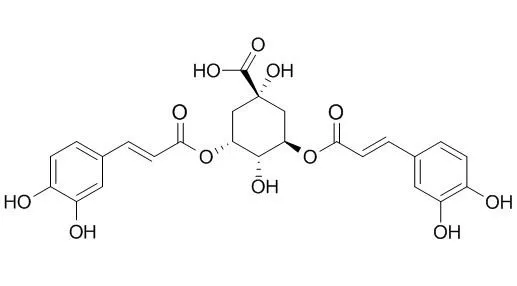| In vitro: |
| Neuroscience. 2010 Sep 1;169(3):1039-45. | | Neuroprotective effect of 3,5-di-O-caffeoylquinic acid on SH-SY5Y cells and senescence-accelerated-prone mice 8 through the up-regulation of phosphoglycerate kinase-1.[Pubmed: 20570715 ] | As aged population dramatically increases in these decades, efforts should be made on the intervention for curing age-associated neurologic degenerative diseases such as Alzheimer's disease (AD). Caffeoylquinic acid (CQA), an antioxidant component and its derivatives are natural functional compounds isolated from a variety of plants.
METHODS AND RESULTS:
In this study, we determined the neuroprotective effect of 3,5-di-O-caffeoylquinic acid on Abeta(1-42) treated SH-SY5Y cells using MTT assay. To investigate the possible neuroprotective mechanism of 3,5-di-O-CQA, we performed proteomics analysis, real-time PCR analysis and measurement of the intracellular ATP level. In addition, we carried out the measurement of escape latency time to find the hidden platform in Morris water maze (MWM), real-time PCR using senescence-accelerated-prone mice (SAMP) 8 and senescence-accelerated-resistant mice (SAMR) 1 mice. Results showed that 3,5-di-O-CQA had neuroprotective effect on Abeta (1-42) treated cells. The mRNA expression of glycolytic enzyme (phosphoglycerate kinase-1; PGK1) and intracellular ATP level were increased in 3,5-di-O-CQA treated SH-SY5Y cells. We also found that 3,5-di-O-CQA administration induced the improvement of spatial learning and memory on SAMP8 mice, and the overexpression of PGK1 mRNA.
CONCLUSIONS:
These findings suggest that 3,5-di-O-CQA has a neuroprotective effect on neuron through the upregulation of PGK1 expression and ATP production activation. | | Nat Prod Res. 2018 Nov 16:1-8. | | Two new phenolic compounds and some biological activities of Scorzonera pygmaea Sibth. & Sm. subaerial parts.[Pubmed: 30445831 ] |
METHODS AND RESULTS:
Phytochemical composition of ethyl acetate fraction and total phenolic content, in vitro antioxidant, anti-inflammatory, antimicrobial activities of petroleum ether, chloroform, ethyl acetate and n-butanol fractions of the ethanol extract obtained from the subaerial parts of Scorzonera pygmaea Sibth. & Sm. (Asteraceae) were investigated. Nine compounds; scorzopygmaecoside (1), scorzonerol (2), cudrabibenzyl A (3), thunberginol C (4), scorzocreticoside I (5) and II (6), chlorogenic acid (7), chlorogenic acid methyl ester (8), 3,5-di-O-caffeoylquinic acid (9) were isolated and identified using spectroscopic methods. All substances were isolated for the first time from this species. Compounds 1 and 2 are new.
CONCLUSIONS:
The fractions showed high antioxidant capacity correlated with their phenolic content and no significant antimicrobial activity against tested bacteria and fungi. COX inhibition test was used to evaluate the anti-inflammatory activity and all the fractions showed low inhibition in comparison with indomethacin. | | Zhongguo Zhong Yao Za Zhi. 2015 Jan;40(2):269-74. | | Anti-complementary phenolic acids from Lonicera japonica.[Pubmed: 26080557] | To study the anti-complementary phenolic acids from Lonicera japonica.
METHODS AND RESULTS:
The anti-complementary activity-directed isolation was carried out with the hemolysis test as guide. All isolation was evaluated for their in vitro anti-complementary activities. The structures were identified by various spectroscopic data including ESI-MS, 1H-NMR, 13C-NMR data.
Fourteen compounds were isolated from the EtOAc fraction of L. japonica extracts, including 8 phenolic acids: 5-O-caffeoylquinic acid (1), chlorogenic (2), 4-O-caffeoylquinic acid (3), 3,5-di-O-caffeoylquinic acid (4), 4,5-di-O-caffeoylquinic acid (5), 3,4-di-O-caffeoylquinic acid (6), caffeic acid (7) and methyl caffeate acid (8); 3 iridoids: secologanoside (9), sweroside (10) and secoxyloganin (11); and 3 flavonoids: luteolin (12), quercetin (13) and kaempferol (14). Compounds 1-9 and 11-14 showed anti-complementary activity in different extents and 3,5-di-O-caffeoylquinic acid (4) exhibited the most significant activity against the classical pathway.
CONCLUSIONS:
Compound 14 is obtained from this plant for the first time, phenolic acids are the main anti-complementary constituents of L. japonica and 3,5-di-O-caffeoylquinic acid(4) is a potential complement inhibitor with strong activity, which worthy to be studied further in the future. |
|






 Cell. 2018 Jan 11;172(1-2):249-261.e12. doi: 10.1016/j.cell.2017.12.019.IF=36.216(2019)
Cell. 2018 Jan 11;172(1-2):249-261.e12. doi: 10.1016/j.cell.2017.12.019.IF=36.216(2019) Cell Metab. 2020 Mar 3;31(3):534-548.e5. doi: 10.1016/j.cmet.2020.01.002.IF=22.415(2019)
Cell Metab. 2020 Mar 3;31(3):534-548.e5. doi: 10.1016/j.cmet.2020.01.002.IF=22.415(2019) Mol Cell. 2017 Nov 16;68(4):673-685.e6. doi: 10.1016/j.molcel.2017.10.022.IF=14.548(2019)
Mol Cell. 2017 Nov 16;68(4):673-685.e6. doi: 10.1016/j.molcel.2017.10.022.IF=14.548(2019)